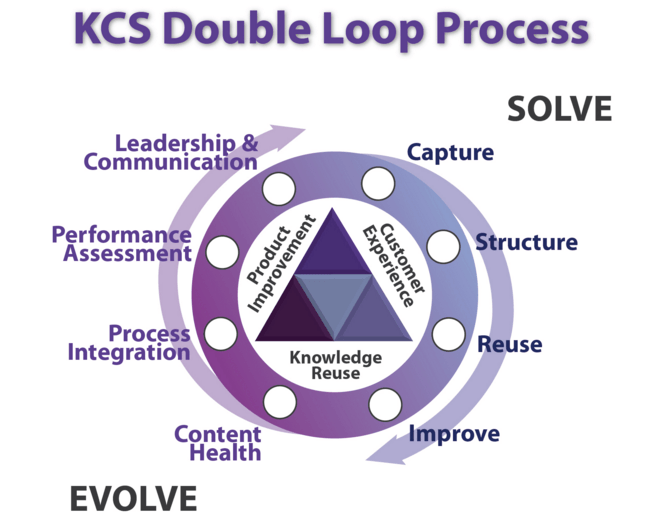Getting Started With Knowledge Centered Support
As you can probably tell from its name, Knowledge Centered Support was originally created to help with knowledge management in customer support departments of companies having to deal with their clientele a lot. However, time has proved that this methodology can be successfully applied in almost any subject area.
Knowledge Centered Support was developed in 1992 by the Consortium for Service Innovation, and is being supported and improved to this day. The main goal of the project was to formulate and share the best practices for gathering, structuring, and reuse of information.
Knowledge Centered Support is based on 4 main principles:
- New content is created as a byproduct of problem solving.
- Popular content is reviewed and expanded.
- Up-to-date collective experience is collected in a knowledge base.
- Learning, cooperation, and knowledge sharing are incentivized.
During the 23 years of its existence, Knowledge Centered Support has seen a lot of revisions and structural improvements, and has turned into a rich methodology with a wide assortment of tools for recording and preserving knowledge. When used correctly, Knowledge Centered Support can become an integral part of daily business processes, and a way for people to solve problems and either create new or update existing content based on the implemented solution.
Despite the fact that KCS is technology-dependent to a significant degree, implementing the methodology effectively is primarily a people problem. The years that Knowledge Centered Support has been in use have proved that the best source for relevant and up-to-day knowledge is the people who use this knowledge in their day-to-day work.
Knowledge Centered Support is based on a number of principles, and implementations can vary from one organization to another, depending on the environment. Although the methodology was initially created for implementation in technical support departments of IT companies, it is actually well-suited for implementation in any information-rich environment with significant knowledge flow. The Consortium has created a detailed guide with technical information on the implementation of Knowledge Centered Support and the proper use of all its functions.
Organizations and companies have long used such Knowledge Centered Support principles as the demand-based creation and development of learning materials, Just-in-Time Knowledge (a concept stressing the necessity of providing the right information to the right people at the right time), and continuous knowledge base improvement to great success. It’s been acknowledged that following these practices improves the efficiency and productivity of an organization.
What Is A “Double Cycle”?
Let’s see what knowledge assets are key to Knowledge Centered Support. This will help you to better understand the methodology and the benefits it can offer.
- Knowledge Centered Support articles.
The sum total of collective experience in problem solving. Such knowledge base articles can contain a wide range of solutions to different issues, from simple instructional “how to” topics to complicated configuration and compatibility information designed for unassisted troubleshooting. - People profiles.
Profiles of customer support personnel, partners, and clients in online communities and social networks. Such profiles usually list the person’s experience, skills, and reputation within a community. This helps to identify subject matter experts and contact them for a consultation. - Customer profiles.
Information about your customers. These can include anything from a detailed description of the customer’s business to a brief containing the company’s business model and objectives. - Customer configurations.
Information about products installed in the customers’ environments together with all relevant configuration data.

Image from KCS Practice Guide.
The instructions authored by the Consortium cover the first item (KCS articles) best. The remaining items and corresponding best practices are planned to be covered in the future, but for now KCS articles are the basis upon which the methodology is largely built.
Seeing as Knowledge Centered Support was initially developed for use in customer support, let’s take a look at the results of research conducted by the Consortium for Service Innovation regarding the benefits of implementing Knowledge Centered Support in such departments:
- Fast problem resolution.
- 50-60% decrease in problem resolution times.
- 30-50% increase in first contact resolution.
- Resource usage optimization.
- 70% decrease in the time required for achieving proficiency.
- 20-35% decrease in employee turnaround.
- 20-40% increase in employee job satisfaction.
- Online self-service implementation.
- 50% decrease in incoming load thanks to unassisted problem solving with the help of online self-service tools.
- Corporate learning implementation.
- 10% decrease in incoming load thanks to product improvements.
- 20% increase in the number of issues resolved by first tier support teams.
As you can see from the data, Knowledge Centered Support works, and has proven itself as a reliable tool for improving operational efficiency of companies. Real-world experience shows that the methodology can be easily adapted to other departments and areas, especially those that involve dealing with customers or are information rich. For example, in Parallels, Knowledge Centered Support has been implemented in IT and DevOps, as well as support, to great effect.
Now you know what Knowledge Centered Support is and what are its benefits. In the next installment I will give some advice on how to implement the methodology in your organization and adapt it to your own needs.








![7 Tips To Use eLearning Infographics To Improve Knowledge Retention [Update 2019]](https://cdn.elearningindustry.com/wp-content/uploads/2017/08/tips-use-elearning-infographics-improve-knowledge-retention.jpg)